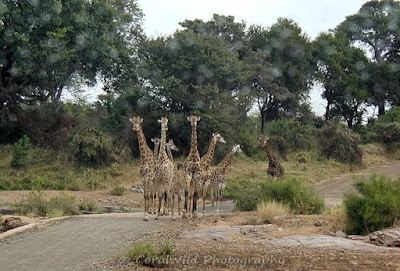Are we going to see a
giraffe?? One of the more common "first"questions I get
when going to Kruger with international guests.
This quirky African
herbivore catches the imagination like few other large mammals.
Yet according to a
published scientific paper (in the journal Current Biology) of
8th September 2016, one reason no-one has identified previously that
there are actually 4 different species (and 5 sub-species) of
giraffe, is that they haven't been studied enough!
(Note:- all these
pictures are of the Southern Giraffe (Giraffa giraffa), South
African sub-species, with one exception - the last Etosha photo shows
giraffe of the Angola sub-species).
So, moving on from
the science of giraffe, I thought it high time I shared with you, on
this blog, a bit more about this striking animal and my experiences
with it.
 |
| A bachelor herd, ranging in age |
One of the coolest
collective names in the animal kingdom is for the giraffe. A "tower"
describes the giraffe in these photos rather well doesn't it?
Less used collective names are also "corps" and "journey".
 |
| Grouping closely together to cross an open area/river bed |
Strangely enough,
although we commonly see giraffe in towers, their social organisation,
as described by Estes, is gregarious but loose, open, casual and
non-lasting. Sorry, I'm taking big liberties with his original text,
but you get my drift?
 |
| Giraffe only feed close together when all on the same tree |
The longest, and best
established bonds are between females and their calves (until they
grow up that is.....)
As a guide I really
shouldn't use the term "cute"but is there any better term
for a giraffe calf??
The amazing thing about
giraffe calves, is that they are already 2 metres (6 feet) tall when
they are born, and the 25 - 50% of calves lucky enough to survive the
lions and hyena in their first vulnerable month, grow another metre
by 6 months, and almost double in height by the time they are 12
months old!
A survival necessity!
Talking of predators,
across Africa adult giraffe are largely invulnerable to most, due to
their size, excellent eye-sight and dangerous hooves.
With the
exception of lion. In Kruger, it is not uncommon to find lion on a
giraffe kill.
Of course, a giraffe's
great size, extra long legs and neck does make them awkward and
vulnerable when they need to drink. As a result they are extra
cautious when approaching water holes and drink as quickly as they
can. Fortunately for them they can survive for many days without
water, as they can get enough from the green leaves they eat, and/or
dew on those leaves (during the wet season).
During winter (our dry
season) you can see they are very challenged to find sufficient leaf
to eat!
Just look at that
tongue!! It's one of the longest in the animal kingdom - up to 45cm
long!!
Giraffe are browsers (I
have been asked before what animals they hunt!!!!) and their
favourite leaves/browse are from acacia trees. But they will feed,
when times are hard from almost any tree that's got leaf - or flowers
as you can see.
A mature male giraffe
can reach up to 5.8 metres, and so tend to browse from the taller trees.
Female giraffe tend to
more commonly browse lower trees and bushes.....
So what do you think
this particular giraffe is doing??! There's no water to be seen!?
Well, it's licking at
mineral-rich soil. I've even seen giraffe suck on old bones. This is
to get extra minerals, especially calcium, into their diet to help
keep their bones strong.
A much more common
sight with giraffe are the ubiquitous oxpeckers. I'm actually
astounded that the pictures above show hardly any sign of an
oxpecker (see if you can spot the one exception!)
So here are a couple of
pics with red-billed oxpeckers, one perched in a typical position and
the other "grazing"on the giraffe's skin.
Despite their long
necks and short bodies, giraffe find it very difficult to groom the
parasites off their skin, so the ox-peckers play a vital role here.
As persistent as the
oxpeckers can be, even they cannot hold on when male giraffe decide
to spar for dominance.
I haven't often
witnessed a serious, high-intensity contest between 2 males, but it
is an impressive, graceful though brutal, slow-motion affair.....
(I've blogged about this before.... to see more pictures click on
Battling Giraffe)
These 2 males are lined
up ready to resume a contest.
Low-intensity contests
can just be a matter of leaning and shoving each other, but
occasionally they escalate to the neck-swinging, head-thudding
stage.....
No known deaths have
occurred during these challenges as it makes much more sense for the
loser to concede the battle and live to try again.
Well, it's time to wind
up this extra long, and informative posting.
Worth it
considering the striking subject?
Here's a last picture,
a favourite landscape from the wide-open spaces of Etosha, Namibia.
References:-
Estes - The Behavior Guide to African Mammals
Carnaby - Beat About the Bush - Mammals


















7 comments:
Great post. Giraffes are fascinating to watch in their gangely yet graceful motion. Saw two young males necking at Augrabies and took video of their performance. Love to see "towers" of giraffes.
Thanks for the visit and comment Gaelyn.
That video must be great. It's difficult to describe in just words or even pictures!
Great post Sue
Thanks Jackie :) <3
Hi Coral - they are wonderful photos ... and the giraffe is an amazing creature ... so lovely to see them loping or walking around -cheers Hilary
Amazing photos and such interesting facts-thank you
Lyn
Hello Hilary, thanks for the visit/comment. Glad you enjoyed the photos.
Thanks Lyn for the feedback :)
Post a Comment